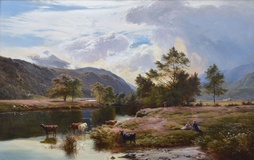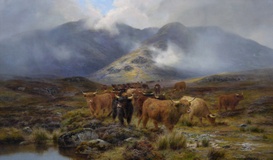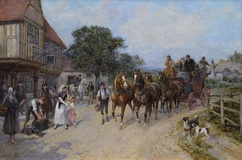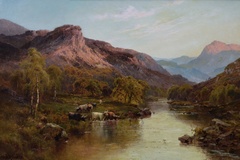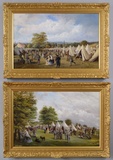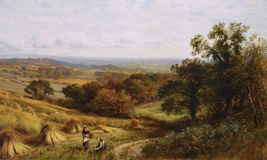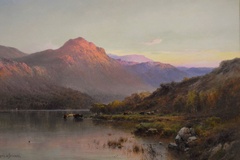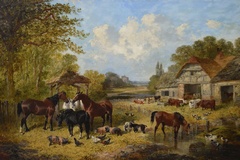Frederick Henry Howard Harris
British, (1829-1901)Volunteer Rifle Soldiers by a Country House & Companion
Oil on canvas, pair, one signed & dated 1872
A fantastic pair of military paintings of British Volunteer Soldiers at an encampment by Frederick Henry Howard Harris. The paintings depict the annual fortnightly camp of two volunteer Rifle Corps. Britain has a long history of recruiting part-time civilian soldiers to help defend its shores, using conscription from 1757. The conscription ballot ended in the early 19th century, however troop shortages after the Crimean War (1854-56) prompted the creation of the volunteer force movement in 1859. Many local Volunteer rifle, artillery and engineer corps were subsequently formed, consisting of men from local trades and businesses. From 1859 to 1908 they played a vital role in national defence until the formation of the Territorial force. The part-time soldiers were required to train for certain number of days each year as well as attend an annual camp which took place over a fortnight. The camps were mainly to provide realistic military training outdoors and were often held on public holidays to prevent inconvenience to employers and employees. They quickly evolved into popular days out for wives and families to visit. Several units had grey uniforms including the Bristol Rifle Volunteers, who also had similar green plumes. (Acknowledgements: Q&C Militaria, Cheltenham and the Royal Birmingham Society of Artists (RBSA) archives).
Frederick Henry Howard Harris was the son of Henry Harris (b.1811), an artist and drawing master and his wife Margaret who lived at 16 Caroline Street, Birmingham. According to official records, he was born on 23 January, 1829 rather than the date of 1826 which has been previously listed. He is also sometimes mistakenly referred to as Francis.
Whilst he was growing up, his parents ran a school in Frederick Street, Edgbaston and it is highly likely he was tutored there by his father and his mother who was a school mistress. His future wife Lucinda Evetts also worked there for a time as an assistant and this is undoubtedly where they first met. By the time of his marriage to Lucinda at Old Church, Edgbaston church on 20 June, 1859 he had established himself as an artist. Together they lived at 18 Harborne road, where his wife later set up a school. Lucinda was nearly 10 years older than him which may have caused a bit of a stir at the time. This could account for the differing birth years recorded on the censuses after their marriage, as they may have wanted to conceal this. As well as travelling around the UK to paint, he also went abroad visiting Europe and Morocco. He exhibited at the Royal Society of Artists, Birmingham becoming a member of the organisation in 1872.
After giving up the school around 1881, the couple moved to Hills Side, Kingscote Road, Edgbaston. Harris spent his final years living at Mariecroft, Margaret Road in Birmingham. He died on 30 December, 1901 at Birmingham.
Examples of his work can be found at the Wolverhampton Art Gallery and the Birmingham Museum.
© Benton Fine Art
| Presentation | The paintings are housed in new, English made gilt frames which are in excellent condition. |
| Condition | As with all of our original antique oil paintings, these works are offered in ready to hang gallery condition, having been professionally cleaned, restored and revarnished. |
Dimensions
| Image Size (each) | 19.5 inches x 30.5 inches (49.5cm x 77.5cm) |
| Framed Size (each) | 26.25 inches x 37.25 inches (66.5cm x 94.5cm) |
You May Also Like















